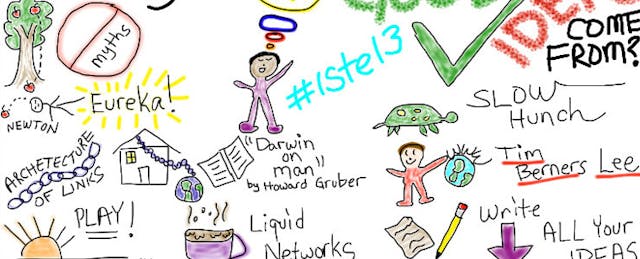The Dara Niemi band kept the crowd entertained as they awaited the keynote, Where Good Ideas Come From, by Stephen Johnson. What an inspiration to hear such a talented group of students!
A hush turned to applause as Mayor Castro of San Antonio took the stage and shared how voters of San Antonio taxed themselves 1/8% sales tax to provide high quality, pre-K education for its residents.
Stephen Johnson took the stage and talked about the new ISTE slogan: “Connected Learning, Connected World.” He described connection as the theme that animates all of his work and posed some key questions:
- Why do we value connections so much?
- What forms of connection are most powerful and lead to most creative and disruptive ideas?
Johnson went on to dispel the myth that ideas come as Eureka moments. He said that they come in environments that share key characteristics and do not happen quickly, though pop culture tends to perpetuate it.
Instead, breakthrough ideas are preceded by a long period of incubation and start as a hunch/feeling, a slow hunch that can stay for months, or even decades, before becoming useful. From Darwin’s discoveries, to the creation of the World Wide Web, Johnson gave examples of the long waiting periods for the fruition of pivotal ideas.
How does this related to thousands of educators in the audience?
Schools can cultivate these by providing the environments to facilitate the collaboration that leads to this slow brewing of ideas.
Johnson shared his own experience with developing ideas using Devonthink, a tool to collect inspirational quotes and find associated ideas and concepts. Devonthink uses latent semantic algorithms that detects subtle connections between quotes.
He called it the modern day "commonplace book", where thinkers in history collected their own pearls of wisdom. Devonthink allows for collected ideas to search and relate to other past ideas, providing the opportunity to remix and invent.
Johnson continued with his engaging storytelling by discussing environments that bred this magic, citing the coffeehouse as mentioned in a recent NY times piece.
What made the coffeehouse such a driver of innovation?
- People gather to have conversations with no single unified purpose.
- Diversity is key in encouraging new ideas; when we surround ourselves with different peoples, we are smarter because ideas are networks. Advice for us: borrow an idea from a field that surprises or challenges us. He cited the Apple Store as an idea similar to a luxury hotel concierge.
Advice for educators: Move outside your traditional domain to seize ideas and build conceptual bridges. Take concepts from architecture and see how they apply to another subject. With this connected movement outside your traditional domain you can take a hunch and turn it into something transformational.
One of the great opportunities we have in K-12 education is the diversity of expertise. Because they are not yet driven by forces of specialization, students have a wonderful opportunity to innovate.
To be creative and innovative to solve problems: we need to move laterally, make surprising serendipitous connections, and build conceptual bridges.
Johnson closed with this thought: Education gives us opportunity for multi-disciplinary connections, and in these connections, innovation lives.


